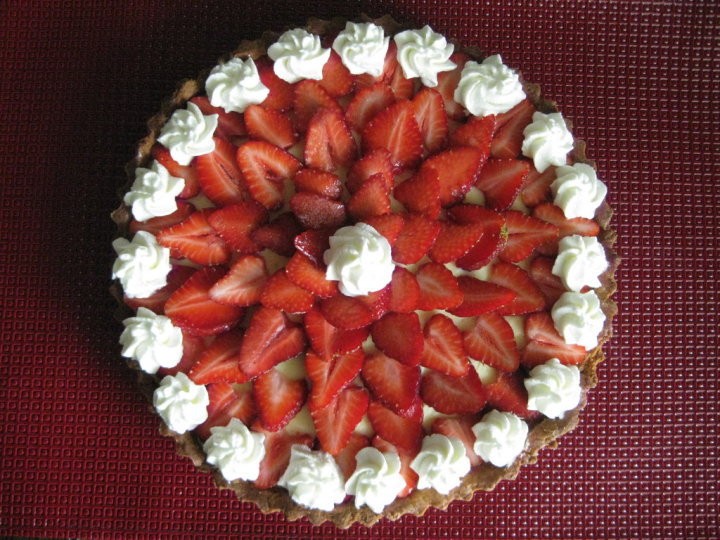After toiling under the hot sun in a strawberry patch for an hour and 20 minutes picking berries, I finally emerged with a gallon of fresh strawberries ... and a sore back. Piedmont Produce, a farm in Monroe, NC, has a pick-your-own strawberry field that sells gallon-sized buckets for $8 each. I visited the farm this past weekend and now have a predicament on my hands: What to do with all these strawberries?
Time for strawberry desserts I guess. First up: Dorie Greenspan's Classic Berry Tart.

The tart consists of a sandy-crumbed sweet tart shell filled cool vanilla pastry cream, and topped lots of sliced strawberries. (I gilded the lily and added some freshly whipped cream too.) The pastry cream isn't overly sweet and pairs nicely with fresh berries. You can sub the strawberries for blackberries, blueberries, or raspberries. Keep the tart refrigerated up to 1 hour or so until ready to serve.
To assemble the tart, you'll need two days. You could possibly hurry the process along and make this in one day, but it's easier to just prep on day one, and assemble on day two. To keep the crust flaky, it's best to wait to assemble the tart as close to serving time as possible, and definitely eat it the day of assembly.
Day 1:
Make tart shell (Make crust dough, chill, bake, cool, refrigerate)
Make pastry cream (cool in refrigerator overnight)
Day 2:
Slice strawberries
Whip cream
Assemble tart
Quick Classic Berry Tart
Makes 6 to 8 servings
About 1 1/2 cups Pastry Cream, cooled or chilled (Recipe Below)
1 9" tart shell made with Sweet Tart Dough (Recipe Below)
2 pints fresh strawberries, sliced, or an assortment of berries
Smooth the pastry cream by giving it a couple of strong turns with a whisk. Spoon enough pastry cream into the tart crust to come almost to the rim, then even the surface with a rubber spatula. Carefully lay the berries on the cream, arranging them in any pattern you wish.
Pastry Cream
Makes about 2 cups
Storing: The pastry cream can be kept tightly covered in the refrigerator for up to 3 days.
2 cups whole milk
6 large egg yolks
1/2 cup sugar
1/3 cup cornstarch, sifted
1 1/2 tsp pure vanilla extract
3 1/2 TBSP unsalted butter, cut into bits at room temperature
Bring the milk to a boil in a small saucepan.
Meanwhile, in a medium heavy bottomed saucepan, whisk the yolks together with the sugar and cornstarch until thick and well blended. Still whisking, drizzle in about 1/4 cup of the hot milk- this will temper, or warm, the yolks so they won't curdle. Whisking all the while, slowly pour in the remainder of the milk. Put the pan over medium heat and, whisking vigorously, constantly and thoroughly (making sure to get into the edges of the pot), bring the mixture to a boil. Keep at a boil, still whisking, for 1 to 2 minutes, then remove the pan from the heat.
Whisk in the vanilla extract. Let sit for 5 minutes, then whisk in the bits of butter, stirring until they are fully incorporated and the pastry cream is smooth and silky. Scrape the cream into a bowl. You can press a piece of plastic wrap against the surface of the cream to create an airtight seal and refrigerate the pastry cream until cold, or, if you want to cool it quickly, put the bowl into a larger bowl filled with ice cubes and cold water, and stir the pastry cream occasionally until it is thoroughly chilled, about 20 minutes.
Sweet Tart Dough
Makes 1 9" Crust
1 1/2 cups all purpose flour
1/2 cup confectioners sugar
1/4 tsp salt
1 stick plus 1 TBSP (9 TBSP) very cold (or frozen) unsalted butter, cut into small pieces
1 large egg yolk
Put the flour, confectioners sugar, and salt in a food processor and pulse a couple of times to combine. Scatter the pieces of butter over the dry ingredients and pulse until the butter is coarsely cut in - you should have some pieces the size of oatmeal flakes and some the size of peas. Stir the yolk, just to break it up, and add it a little at a time, pulsing after each addition. When the egg is in, process in long pulses - about 10 seconds each- until the dough, which will look granular soon after the egg is added, forms clumps and curds. Just before you reach this stage, the sound of the machine working the dough will change- heads up. Turn the dough out onto a work surface and, very lightly and sparingly, knead the dough just to incorporate any dry ingredients that might have escaped mixing.
Butter a 9" fluted tart pan with a removable bottom. Press the dough evenly over the bottom and up the sides of the pan, using all but one little piece of dough, which you should save in the refrigerator to patch any cracks after the crust is baked. Don't be too heavy-handed - press the crust in so that the edges of the pieces cling to one another, but not so hard that the crust loses its crumbly texture. Freeze the crust for at least 30 minutes, preferably longer, before baking.
Preheat the oven to 375. Butter the shiny side of a piece of aluminum foil and fit the foil, buttered side down, tightly against the crust. (Since you froze the crust, you can bake it without weights.) Put the tart pan on a baking sheet and bake the crust for 25 minutes. Carefully remove the foil. If the crust has puffed, press it down gently with the back of a spoon.
Bake for another 8 minutes or so, or until it is firm and golden brown. Transfer the tart pan to a rack and cool the crust to room temperature before filling. (I refrigerated my crust at this point.)
